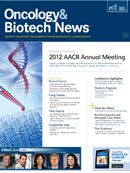Publication
Article
Oncology & Biotech News
Naproxen Cuts Pegfilgrastim-Induced Bone Pain
Author(s):
The nonsteroidal anti-inflammatory drug naproxen significantly decreases the incidence, severity, and duration of pegfilgrastim-induced bone pain in patients diagnosed with a nonmyeloid cancer.
Jeffrey J. Kirshner, MD
The nonsteroidal anti-inflammatory drug naproxen significantly decreases the incidence, severity, and duration of pegfilgrastim-induced bone pain in patients diagnosed with a nonmyeloid cancer, according to the results of a phase III study.
The introduction of the growth factor pegfilgrastim has helped oncologists administer full-dose myelosuppressive therapy on schedule and enabled the development of dose-dense chemotherapy, which reportedly boosts survival in patients with breast cancer, the investigators observed. However, pegfilgrastim-induced bone pain is a significant clinical problem, and it may sometimes be necessary to discontinue pegfilgrastim use, thereby interfering with adequate dosing of chemotherapy and potentially decreasing curability.
Jeffrey J. Kirshner, MD, director of Research at Hematology/Oncology Associates of Central New York in East Syracuse, and coworkers randomized 510 patients to treatment with either 500 mg of naproxen twice daily or placebo on the day of pegfilgrastim administration. The regimen was continued for 5 days after pegfilgrastim, and for up to 8 days if the patient was still experiencing pain.
Study participants, all of whom had nonmyeloid cancer, maintained a journal in which they recorded daily pain severity on a scale of 0 (no pain) to 10 (pain as bad as you can imagine) for the previous 24 hours, as well as pain duration. Sixty-seven percent of patients in the study had breast cancer and 10% had lung cancer.
There was a significant reduction in the percentage of patients who experienced any pain, from 71.3% to 61.1% (P = .020) in the placebo and naproxen groups, respectfully. The agent also decreased severe pain from 27.0% to 19.2% (P = .048) and overall pain duration from 2.40 to 1.92 days (P = .009).
The data also revealed that the area under the curve for bone pain for days 1 through 5, the primary outcome measure, was 7.71 for the placebo group versus 6.04 for the naproxen group (P = .037).
“In practical terms, per the results of our study, if 100 patients were treated with naproxen, 10 would benefit in terms of preventing pegfilgrastim-induced bone pain; 29 would never have experienced any pain at all, regardless of any preventive treatment; and 61 patients would have still experienced pain, despite the naproxen,” Kirshner et al wrote.
They were not able to pinpoint any clinical risk factors for the onset of pegfilgrastim-induced bone pain.
The investigators cautioned that despite being treated with naproxen, more than 60% of patients continued to experience pain. Of these patients, 19% reported severe pain. The findings underscore the need for additional studies of naproxen or other drugs for preventing pegfilgrastim-induced bone pain, according to the investigators.
Kirshner JJ, Heckler CE, Janelsins MC, et al. Prevention of pegfilgrastim-induced bone pain: a phase III double-blind placebo-controlled randomized clinical trial of the University of Rochester Cancer Center Clinical Community Oncology Program Research Base [published online ahead of print April 16, 2012]. J Clin Oncol. doi: 10.1200/JCO.2011.37.8364.










